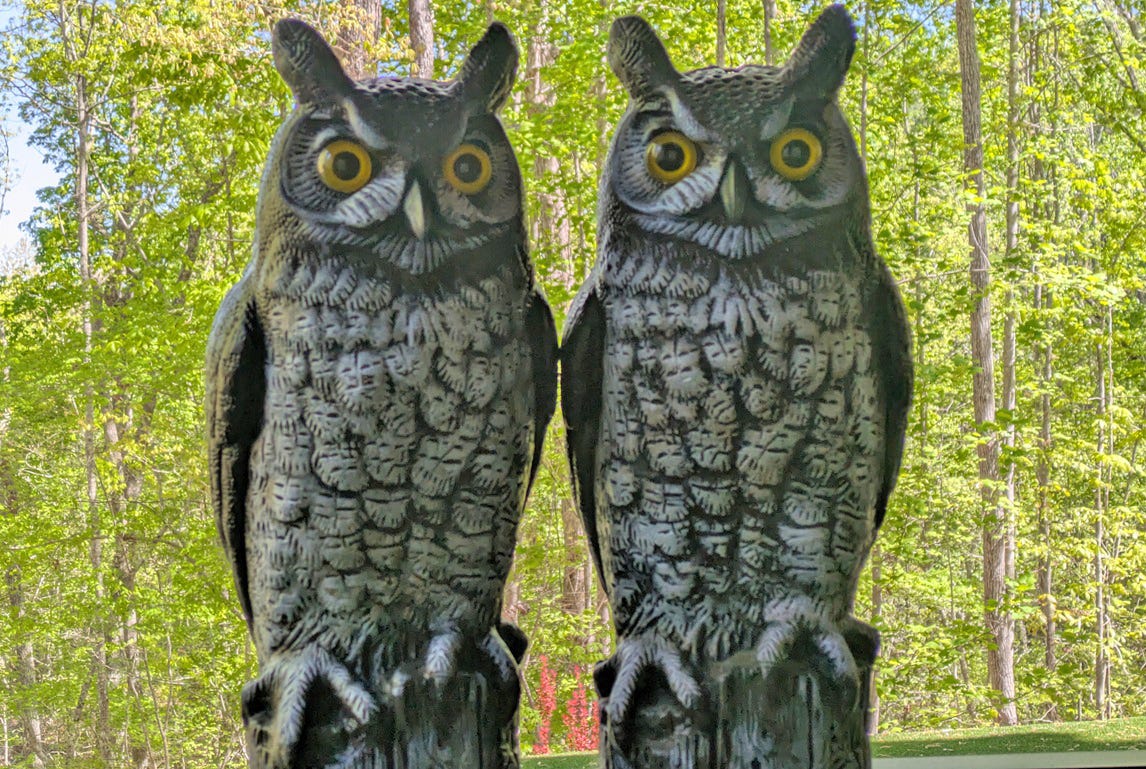Birds, Keep the Flock Off My Patio
I love you guys, but you're getting doo-doo on the flagstone
I love birds. Their melodious songs. Their radiant feathers. They eat pesky bugs, spread seeds and help with pollination. In short, birds are essential to a healthy ecosystem.
But must they poop on my patio?
I’m not the only one who is irked. Because as great as they are for nature, they’re also great at damaging homes and gardens. Woodpeckers bore into wood siding; pigeons roost in rafters; geese gobble up grass seed and other winged thieves raid orchards and garden beds.
Your local, independent hardware store carries a number of products designed to deter birds. No one product works on all bird species, and some products work well for awhile—until birds become habituated to them.
The answer you don’t want to hear: You’ll have to experiment with different solutions, and mix them up over time to keep birds from coming back.
A few years ago, we bought 16 dangling reflectors for our patio that our friend Charlie P. told us about. They look like giant silver earrings. They turn in the wind and reflect light, which apparently scares the birds. We hung these reflectors from eye hooks screwed to the undersides of our patio joists. (By “we” I mean “Chuck.”) They have worked great. UNTIL NOW. At least one bird sits on top of a wall-mounted patio light and poops on the flagstone. That bird invited a friend to sit on a string light and poop elsewhere on the flagstone.
For our next attempt, here are some options:
Sticky goo that comes in a caulk tube: This goo is squeezed on top of the surface where birds like to perch. Apparently, they hate the feel of the compound on their feet. I’m going to reject this method. Some of the buyers’ reviews explain why.
Please don't use this product, find another means.
Keeps birds off ledge. BUT if they step both feet into it, you will have to help release them from the goo, which is not fun.
THIS IS NOT A REPELLENT, IT IS A DEATH SENTENCE! Birds can get covered in goo that will not wash off, which they will then ingest, leading to a slow and agonizing death.
Birds get stuck in this and die! It's awful!
Plastic predators. Life-size hawks, owls and falcons can be mounted on posts, deck railings and in eaves to scare birds away. We purchased two plastic owls that successfully terrified our cats. The birds, not so much. Because the owls didn’t move, the birds just used them as a place to hang out and gossip.
Netting. This is a commonly used bird deterrent, especially around fruit-bearing bushes. We installed netting (by “we,” I mean “Beth”) around some shrubs to keep the deer away. But unbeknownst to us, a rather large snake got trapped under the netting and died. His rotting corpse, concealed by the bush, smelled just like a gas leak. I called the gas company, and the technicians were convinced that the source of the leak was a gas line buried underneath the sidewalk. As one technician unloaded a giant wet saw to rip up the concrete, the other technician traced the odor back to the dead snake. Whew! That night, we had to cut the netting off the bush and bury the incredibly stinky snake. (By “we,” I mean “Beth,” because Chuck is afraid of snakes, even decomposing ones.) This is a very prolix way of saying that netting has its downsides because of all the other critters it can ensnare.
Metal tines. They are metal spikes that are tacked along the ledge where birds like to perch. I think this is going to be our next attempt. The reviews are mostly positive, with homeowners saying that it keeps birds away without hurting them. It also says the tines can be adjusted to suit the space you’re trying to block.
One homeowner, however, included a picture in which a bird built a nest within the tines.








We (by we, I mean me) love (and fear) your snake story.